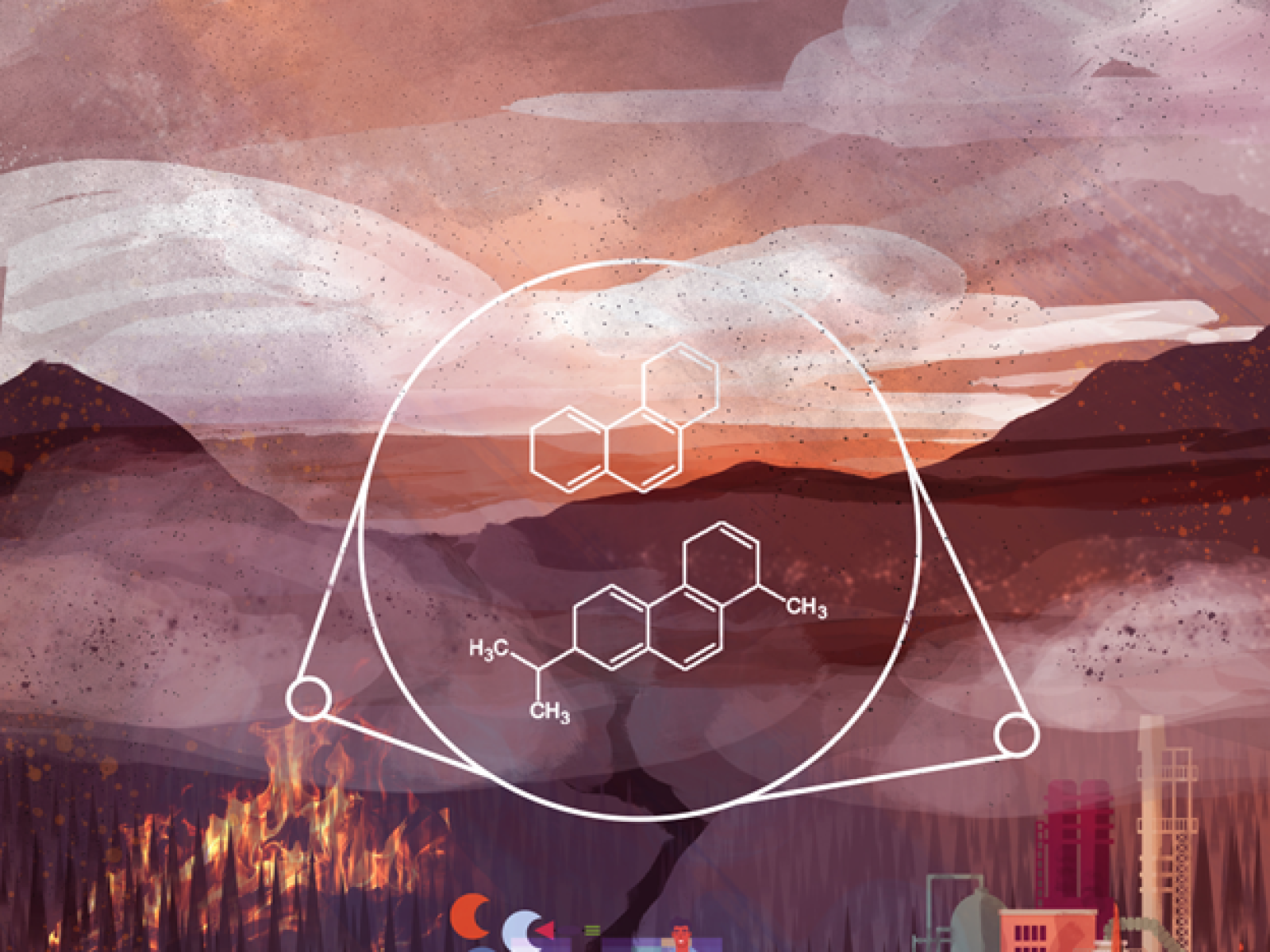Understanding Metabolism of Wood Smoke Pollutants: Implications for Early Life Exposure to PAHs
Wildfires and industry are common sources of polycyclic aromatic hydrocarbons (PAHs). Metabolism of PAHs ultimately determines risk to people living near these hazards.

Wildfires and industry are common sources of polycyclic aromatic hydrocarbons (PAHs). PAH metabolism determines rates of bioactivation, rates of detoxification, and ultimately risk. This study used activity-based protein profiling (ABPP) to characterize cytochrome P450 enzymes in young individuals (≤ 21 months) compared to adults to assess potential of early life susceptibility.
(Illustration by Stephanie King | Pacific Northwest National Laboratory)
The Science
We studied how infants metabolize two pollutants, phenanthrene and retene, found in wood smoke, compared to adults. Using human liver samples from infants (up to 21 months old) and a pooled sample mostly of adults, we measured how fast these pollutants were broken down.
We used activity-based protein profiling (ABPP) to characterize cytochrome P450 enzymes (CYPs) in the same liver samples. We observed no statistically significant differences in phenanthrene metabolism as a function of age, although samples from the youngest individuals had the slowest phenanthrene metabolism rates. In other words, we found that infants metabolize phenanthrene at similar rates as adults, but the youngest infants did so more slowly. For retene, metabolism speeds up with age, reaching adult levels by about 12 months. We identified specific liver enzymes responsible for breaking down these pollutants. This is the first evidence showing that infants metabolize these pollutants slower than adults. We linked PAH metabolism to specific enzymes identified using ABPP. To our knowledge, this is the first evidence that suggest infants metabolize PAHs slower than adults.
The Impact
Every day, humans are exposed to polycyclic aromatic hydrocarbons (PAHs), a group of environmental contaminants found in smoke. Some PAHs are toxic and can cause neurodevelopmental effects and cancer. Human metabolism of PAHs determines the toxicity through bioactivating and detoxifying mechanisms. Our findings help to understand how early life exposure to PAHs may pose health risks. Future research will investigate whether infants are more susceptible to the toxic effects of PAHs because of slower metabolism rates.
Summary
A growing body of literature has linked early life exposures to polycyclic aromatic hydrocarbons (PAH) with adverse neurodevelopmental effects. Once in the body, metabolism serves as a powerful mediator of PAH toxicity by bioactivating and detoxifying PAH metabolites. Since enzyme expression and activity varies considerably throughout human development, we evaluated infant metabolism of PAHs as a potential contributing factor to PAH susceptibility. We measured and compared rates of phenanthrene and retene (two primary PAH constituents of woodsmoke) metabolism in human hepatic microsomes from individuals ≤ 21 months of age to a pooled sample (n=200) consisting primarily of adults. We used activity-based protein profiling (ABPP) to characterize cytochrome P450 enzymes (CYPs) in the same hepatic microsome samples. Once incubated in microsomes, phenanthrene demonstrated rapid depletion. Best fit models for phenanthrene metabolism demonstrated either 1 or 2 phases, depending on the sample, indicating that multiple enzymes could metabolize phenanthrene. We observed no statistically significant differences in phenanthrene metabolism as a function of age, although samples from the youngest individuals had the slowest phenanthrene metabolism rates. We observed slower rates of retene metabolism compared to phenanthrene also in multiple phases. Rates of retene metabolism increased in an age-dependent manner until adult (pooled) metabolism rates were achieved at ~12 mo. Whether the slower metabolism of these PAHs in infants leads to higher or lower toxicity remains to be determined via future studies. ABPP identified 28 unique CYPs among all samples, and we observed lower amounts of active CYPs in individuals ≤ 21 months of age compared to the pooled sample. Phenanthrene metabolism correlated to CYPs 1A1, 1A2, 2C8, 4A22, 3A4, and 3A43, and retene metabolism correlated to CYPs 1A1, 1A2, and 2C8 measured by ABPP and vendor-supplied substrate marker activities. These results will aid efforts to determine human health risk and susceptibility to PAHs exposures during early life.
PNNL Contact
Jordan N. Smith, jordan.smith@pnnl.gov, Pacific Northwest National Laboratory
Jordan Smith has a joint appointment with Oregon State University.
Funding
This research was supported by the National Institute of Environmental Health Sciences (NIEHS) and employed proteomics capabilities supported by the National Institute of General Medical Sciences (NIGMS) Research Resource for Integrative Biology. A portion of the research was performed using EMSL, a DOE Office of Science User Facility sponsored by the Office of Biological and Environmental Research. PNNL is a multiprogram laboratory operated by Battelle for the US Department of Energy.
Research reported in this publication was supported by the National Institute Of Environmental Health Sciences of the National Institutes of Health under Award Number P30ES030287. The content is solely the responsibility of the authors and does not necessarily represent the official views of the National Institutes of Health.
Published: August 19, 2024
Gaither KA, Garcia WL, Tyrrell KJ, Wright AT, Smith JN. 2024. Activity-Based Protein Profiling to Probe Relationships between Cytochrome P450 Enzymes and Early-Age Metabolism of Two Polycyclic Aromatic Hydrocarbons (PAHs): Phenanthrene and Retene. Chemical Research in Toxicology. 37(5): 711-722. [DOT:10.1021/acs.chemrestox.3c00424]